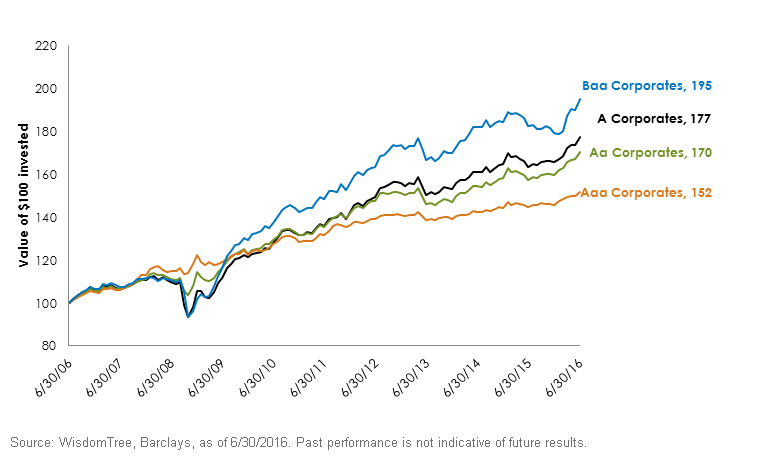Putting Some Income in Fixed Income


 Aaa Corporates, Aa Corporates, A Corporates, and Baa Corporates proxied by each credit ratings sub-index of the Barclays US Corporate Investment Grade Index.
Against this backdrop, income-based solutions should continue to be the goal for bond investors. However, it is important to consider how yield enhancement may be achieved, and the potential risks that could be involved. Oftentimes, the pursuit of additional income involves placing bets too far out in duration (interest rate risk) and/or going too far down the credit ratings curve (credit risk). Given an investor’s parameters, high-yield corporates and emerging market debt could be viewed as solutions for income, but for core fixed income portfolios these types of investments may be viewed as adding too much incremental risk.
In our opinion, a more disciplined approach, which does not involve “reaching for yield,” would be to focus on the relative value differentials that exist in the investment-grade universe. In other words, reallocating positions among the interest- and credit-sensitive arenas. In our interest rate scenarios, we feel an over-weight to Treasuries is not only suboptimal but also susceptible to any potential unexpected rise in rates. The sector of fixed income that we feel could offer the best relative value is investment-grade (IG) corporates. Not only could this sector provide a visible yield advantage to Treasuries, it can also offer some risk mitigation from rising rates if the economy improves. In fact, the average yield for an IG corporate is almost double the yield of a UST 10-Year note, something that has happened only twice before. Within the IG corporate sector, we focus on the Baa area. This rating exhibited lower correlations to Treasuries while also offering strong absolute returns relative to other credit quality sectors.
Conclusion
The WisdomTree Barclays U.S. Aggregate Bond Enhanced Yield Fund (AGGY) is suited as both an income solution and the core fixed income aspect of an investor’s portfolio. Its risk characteristics are well placed for a variety of interest rate landscapes and/or event risks that can come about.
Aaa Corporates, Aa Corporates, A Corporates, and Baa Corporates proxied by each credit ratings sub-index of the Barclays US Corporate Investment Grade Index.
Against this backdrop, income-based solutions should continue to be the goal for bond investors. However, it is important to consider how yield enhancement may be achieved, and the potential risks that could be involved. Oftentimes, the pursuit of additional income involves placing bets too far out in duration (interest rate risk) and/or going too far down the credit ratings curve (credit risk). Given an investor’s parameters, high-yield corporates and emerging market debt could be viewed as solutions for income, but for core fixed income portfolios these types of investments may be viewed as adding too much incremental risk.
In our opinion, a more disciplined approach, which does not involve “reaching for yield,” would be to focus on the relative value differentials that exist in the investment-grade universe. In other words, reallocating positions among the interest- and credit-sensitive arenas. In our interest rate scenarios, we feel an over-weight to Treasuries is not only suboptimal but also susceptible to any potential unexpected rise in rates. The sector of fixed income that we feel could offer the best relative value is investment-grade (IG) corporates. Not only could this sector provide a visible yield advantage to Treasuries, it can also offer some risk mitigation from rising rates if the economy improves. In fact, the average yield for an IG corporate is almost double the yield of a UST 10-Year note, something that has happened only twice before. Within the IG corporate sector, we focus on the Baa area. This rating exhibited lower correlations to Treasuries while also offering strong absolute returns relative to other credit quality sectors.
Conclusion
The WisdomTree Barclays U.S. Aggregate Bond Enhanced Yield Fund (AGGY) is suited as both an income solution and the core fixed income aspect of an investor’s portfolio. Its risk characteristics are well placed for a variety of interest rate landscapes and/or event risks that can come about.
Important Risks Related to this Article
There are risks associated with investing, including possible loss of principal. Fixed income investments are subject to interest rate risk; their value will normally decline as interest rates rise. Fixed income investments are also subject to credit risk, the risk that the issuer of a bond will fail to pay interest and principal in a timely manner or that negative perceptions of the issuer’s ability to make such payments will cause the price of that bond to decline. Investing in mortgage- and asset-backed securities involves interest rate, credit, valuation, extension and liquidity risks and the risk that payments on the underlying assets are delayed, prepaid, subordinated or defaulted on. Due to the investment strategy of the Fund, it may make higher capital gain distributions than other ETFs. Please read the Fund’s prospectus for specific details regarding the Fund’s risk profile.
Credit ratings apply to the underlying holdings of the Fund, and not to the Fund itself. S&P and Moody’s study the financial condition of an entity to ascertain its creditworthiness. The credit ratings reflect the rating agency’s opinion of the holdings financial condition and histories.


